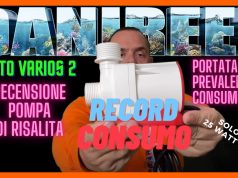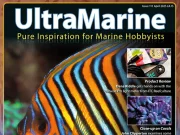
During the 2022 edition of the Interzoo in Nuremberg we had met the sales managers of the German company Schego. On that occasion they had presented us with some new products from their catalog, which specializes in heaters, aeration pumps and accessories for aquariums and ponds.
This article is also available in: Italiano
I remember that time our attention had immediately settled on the Slimline series of heaters, whose interesting features had firmly impressed us. We waited some time, eager to try them out, until they were made available on the market starting in December 2022.
The SCHEGO heater from the Slimline Titanium series, equipped with PTC technology, is a concentrate of technology and functionality, built according to solidity and efficiency.
Not even time to see it arrive on the suppliers’ lists, that the very kind people in charge of SCHEGO had sent us one to test. And not just a random one, but specifically the 600Watt model, which is the largest among the heaters in the entire series. What better opportunity to put it to the test in one of our tanks!
Our video review of the Schego Slimline
Before we continue in the article: this is the link to our video on YouTube with all the testing we conducted on the PTC technology and where you can see the Schego Slimline Mod.506 in action. The video is in italian language but you can activate the subtitles then choose english, or whatsoever language you prefer.
A tradition of excellence
For those who have never heard of it, let me remind you that Schego is a German company created back in 1949. The acronym Schego is nothing but the union of the last names of the two founders, namely Fritz SCHEmel and Kurt GOetz.
In over 65 years this company has been able to establish itself in the aquarium world, as well as in the bio-medical and hospital sectors, with products marked by practicality, functionality and absolute efficiency.
An irreplaceable object
The heater is one indispensable item to manage any aquarium, whether freshwater or marine. An essential accessory in the winter season, it allows us to keep the temperature in the tank constant and stabilize it at the optimal parameters for the type of animal we are going to house.

When it comes to heaters, it is difficult to find one product that stands above another in quality of assembly, technology, and efficiency. In fact, more or less all are constructively similar. A winding that heats up when current flows through it, as it resists the passage of electrons and radiates heat through an external chassis, by transmitting it to the water in which it is immersed.
The infamous heaters are definitely a major cause of our rising energy costs in the winter season.
When we consider that all the electricity we supply to them is converted into heat and dispersed all around, we can see how by their very nature they are among the least efficient devices in the world.
So are all heaters the same?
Absolutely not! And this brand new SCHEGO is proof of that!
The Schego Slimline series of heaters
As mentioned, the Slimline series was marketed in December 2022, although it was some time before it became available in some stores.
This heater brings a substantial upgrade over the older Schego series with the titanium chassis, which many of you may have enjoyed in the past. The major difference lies in the use of Positive Temperature Coefficient (PTC) technology to ensure maximum heating efficiency in every situation.

Available in four models with variable wattage, these heaters are decidedly higher than the previous series.
Below are the main technical and measurement data of the various models:
- Schego Slimline Mod. 501 – 100 W measures 150 mm and has a diameter of 12 mm;
- Schego Slimline Mod. 502 – 200 W measures 250 mm and has a diameter of 12 mm;
- Schego Slimline Mod. 503 – 300 W measures 350 mm and has a diameter of 12 mm;
- Schego Slimline Mod. 506 – 600 W measures 550 mm and has a diameter of 12 mm.
The overall dimensions are therefore quite generous, a factor to consider when purchasing. In fact, it is evident how the larger models impose on us a horizontal positioning so that the water column does not come out. We are unlikely to find a sump 55 centimeters high to house a heater like the Slimline Mod. 506 vertically.
Review: The Schego Slimline Mod. 506 600W Titanium Heater
The model under test is the one with 600 watts of power, namely the Model 506. It is the highest-performing of the entire series and is definitely notable for its considerable size, counting a height of an impressive 55 cm.
In fact, the radiant surface area has been decreased from about 274 sq. cm. in the old version to about 207 sq. cm. in the new one. This new format makes better use of the radiant capabilities of titanium, partly due to the new positive temperature coefficient element that is at the heart of the system.
Recall that titanium has an average thermal conductivity decidedly higher than glass, with 21.9 W/(m-K) versus 0.5-1 W/(m-K).
The packaging
The packaging of the heater is quite straightforward and simple. A white cardboard box, with clean and essential graphics, leaves the entire scene to the radiant element, deliberately placed on the outside so that it is clearly visible and accessible to the touch.

In short…few frills!
It gets straight to the point, immediately hinting that there is substance and there is no need to hide it behind other gimmicks. Inside the box we find the instruction booklet in German and English. Completing the kit are two clips with respective suction pads for easy placement on the glass. In our package there was no manual in Italian. We, however, received the version for the German market, as evidenced by the black band on the front of the packaging.
IP68 certification
The heater is certified with protection rating IP68, a standard that identifies electronic devices that are dust-resistant and protected against permanent immersion. In addition, the stainless characteristics of titanium guarantee safe use due to the absence of oxide or rust, even in prolonged contact with seawater. We can therefore safely immerse it in the tank or sump without having to worry about anything. The only plastic part is the small top terminal from which the 1.5-meter power cord starts.
No control system
There is a complete lack of any electronics to turn the heater on or off when a given temperature is reached. An external management system will therefore be needed. An aquarium computer would be ideal, but we could also consider a thermostat such as the TR2, also in the Schego catalog.
The heater then turns on as soon as you plug the Shuko type plug into the outlet. This is a rather important detail and should be taken into account when purchasing.
Solidity and build quality
Constructively perfect, the heater is a true jewel of engineering. The chassis welds are joined with the utmost care and there are no flaws in the shape, which is simple and efficient. This is not always obvious, especially considering that titanium requires specific welding techniques. Often such welding is done manually by very highly skilled personnel, which makes the whole process quite expensive.

I must say that I have dealt with many heaters in my aquarium life, but never has one left me with the sense of solidity and compactness that I have had with this one. Visually then it is really beautiful in its clean, sleek lines.
The positive thermal coefficient operation
The real breaking point with the previous series, however, is characterized by operation in PTC, or Positive Temperature Coefficient.
But what does this new technology consist of?
The real heart of the heater is a radiant element with autoregulatory characteristics. Let us try to explain in a simple way what this entails.
In the initial stage, when the temperature difference between the radiant element and the water is high, heat extraction is at its maximum. This causes the output to increase by pushing the device to the maximum. Thereafter, as the thermal delta decreases, dissipation and current flow decrease, and consequently power consumption also tends to decrease.
This scheme leads to two main advantages:
- optimization of consumption, since when working with little heat exchange, the heater decreases its current load.
- no overheating problem because as the outdoor temperature increases, the element lowers its heat output while still remaining within a safe range.

Our test
It is difficult to find benchmarks on which to base an evaluation for a heater. We therefore decided to conduct a test by measuring the power consumption through our usual RCE PM600 meter.
To realize then the operation of the PTC element, we tried to understand what was the trend of current consumption as the temperature of the external media changes. We would expect a very high current consumption in the first phase of operation. In that phase the thermal delta to be bridged is at its maximum (considering as delta the temperature difference between the heater and the water to be heated). This consumption should then gradually decrease as the water temperature increases, that is, when the thermal delta tends to decrease.
At the time of measurement, our test room had an ambient temperature of 19.9° C.
We set up a container with water (in our case salted, as it was ready to be fed for a partial change). With the water at an initial temperature of 18.6° C, we put in our heater and connected the power supply. We considered a time frame of 1 hour, taking measurements at 5-minute intervals from each other with the RCE PM600 consumption meter.
The results of the surveys
The measured values are as you can see in the table below:

PLEASE NOTE: The values used to complete the table and graph are those taken in the video. The photos below were taken a few seconds after the video was recorded and, due to fluctuations in the measuring apparatus, are slightly different although they remain substantially consistent.




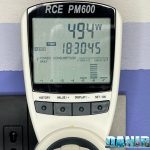


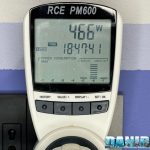
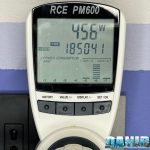




For simplicity we have combined the results into a graph where we find:
- on the horizontal axis the THE TIME PASSED (measurements were taken at 5-minute intervals from each other, from 18:10 to 19:10);
- on the vertical axis in light blue the INSTANTANEOUS CONSUMPTION (expressed in watts);
- on the vertical axis in orange the TEMPERATURE of the water (measured in Celsius degrees).
We see that in our simulation, with an amount of 50 liters of water, the heater was able to raise the temperature from 18.6° C to 29.8° C in just one hour. A respectable increase, with as much as 11.2° C thermal delta.
But how has instantaneous power consumption varied over time?
This is the data we are particularly interested in to better understand how a PTC device works. As we can see the consumption trend was downward for most of the test. To consider that the second reading is objectively a bit abnormal, probably due to the fact that I had mistakenly stirred the water in the drum during those minutes.
We started from a detected value of 530 watts in the first measurement, gradually going down to stabilize around 450 watts. The last four or five readings are in fact more or less in the same range.

Of course, we tested it more or less in its normal range of use, it was not paying to push beyond that.
We will hardly need to bring our water to temperatures above 26-27° C. Perhaps during some water changes it might happen but the conditions of our aquariums do not require such high temperatures. It is safe to assume that consumption values cannot drop much further. After all, a resistor is still a resistor, and therefore one of the least efficient loads that can exist.
The real test case
In any case, before completing this review, we continued to test the heater for a long time. After taking measurements, we kept it running all winter in a tank of about 800 liters, as the main heater, arranging for a possible second heater to be used on colder days.
The test tank measured 180x80x50, with a net liter of about 600 liters + 180 liters sump, for a total of about 780 liters.
As seen above, the heater does not have intervention control electronics. For this reason, switching on and off was devolved to an external control system (3lements Aquago in our case).

The temperature sensor located in the descent compartment turned the relay on at the 23° C threshold on descent. The switch-off was set at 23.5° C on ascent. Our goal was to maintain a temperature range of 23 to 23.5° C, with a hysteresis of 0.5° C. A second temperature sensor placed in the vicinity of the main tank indicated to us the temperature of the surrounding air, confirming our environmental thermostat, set for heating at 20° C during the day and 17° C during the night. Throughout the period under consideration, the heater performed excellently, ensuring that the temperature was maintained even on the coldest days, without the need for the additional heater.
As we expected, we did not encounter any construction or functional problems. After more than five months of use in salt water, the titanium body of the chassis looked as good as new, as did the plastics and wiring. With increasing ambient temperatures then, its operating range gradually became thinner and thinner. Therefore, in the spring we put it back in the box, awaiting its future use.
Personally, I do not like to keep in the sump what I am not using, but I am sure there would be no problem in leaving it submerged continuously, because of the stainless characteristics inherent in titanium. As this last winter season approached, the heater was finally relocated to the sump, where it still performs its excellent task.
Conclusions
Let us sum up then, saying first of all that the purchase price for this type of heater is slightly higher than that of classic heaters. It starts from 75-80 € of the Schego Slimline Mod. 501 – 100 W, the smallest in the series.
The Mod. 502 and 503 can be found for €95 and €115, respectively, while for the Mod. 506 that we had on trial we get to spend about €165.
A fairly large amount of money, however, which is surely justified by the build quality of the product and the fact that it can definitely be considered an “ultimate” purchase. The efficiency characteristics are very high and the solidity of the materials is evident.
We are dealing with a product that, once purchased, you will get to enjoy and use for many many years from here to come. Let us therefore consider it a small investment, to have an unquestionably functional and efficient object. The added value then, in addition to modern operating technology, is a minimal, clean and attractive aesthetic for an object that, in spite of its use tending to be outside the spotlight, we can safely call beautiful!!!
We leave you with the link to the manufacturer’s website, to take a closer look at all the products in the catalog: https://schego.de/en/hobby/aquarium-technology/
What do you guys think? Have you already provided a heater for your tank?
Perhaps it could prove to be a great gift idea, to have a useful and durable item, or you could give it to another aquarist friend of yours who, I’m sure, would appreciate it so much!









